Learn how to make rose petal vinegar with this easy recipe and step-by-step tutorial. Beautifully fragrant rose vinegar offers skin benefits and a pop of color to all of your DIY beauty creations. Read on to find out how to use rose vinegar for skin, hair, and body care.
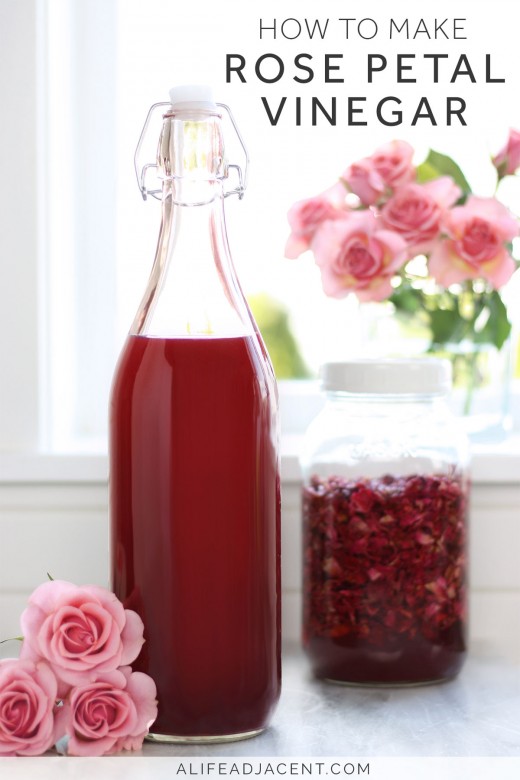
When we mistakenly ordered 2 pounds of dried rose petals, I was eager to discover all the different ways I could incorporate them into my DIY skincare and beauty routine. And that’s how this rose petal vinegar recipe was born.
Roses have been a skincare standby for centuries, and for good reason. No matter your age or skin type, you can benefit from including rose-infused products in your skincare regimen.
You can infuse anything with rose petals. Not only do they smell intoxicating, but they also possess a plethora of therapeutic properties, making them a wonderful addition to your homemade skincare arsenal.
More skincare recipes with rose petals:
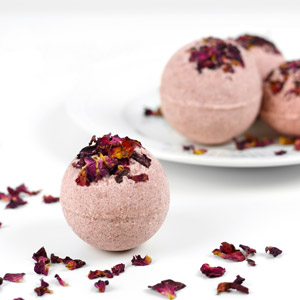
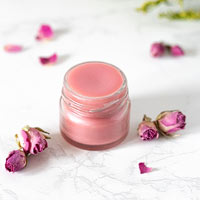
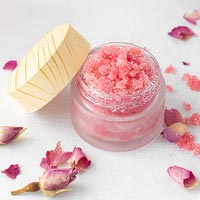
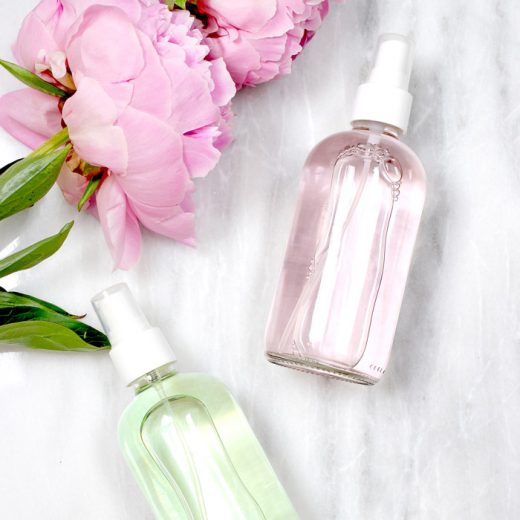
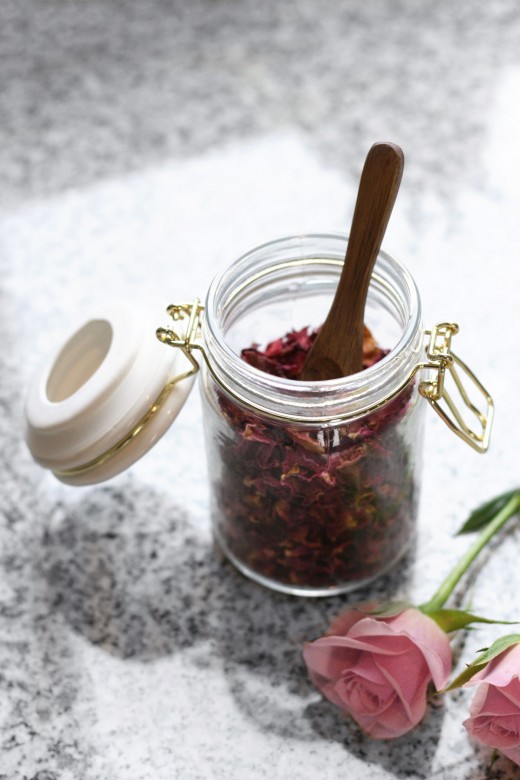
Rose petal vinegar for skincare
If you’re looking to incorporate roses into your skincare routine, there are many other options besides rosewater or expensive rose essential oil.
One of the easiest ways to reap the benefits is by using rose petal infused vinegar. In this recipe, apple cider vinegar (which has a host of its own healing properties) is the vehicle for all of the roses’ benefits.
Rose petal vinegar has quickly become one of my favourite ways to give my sensitive skin and scalp a little extra TLC. It’s extremely easy to make, and yields a potent, fragrant vinegar with a variety of different uses for skin, hair, and body care.

Plain apple cider vinegar is very therapeutic, but it’s not particularly exciting to use. But there’s something about rose petal infused vinegar that makes your homemade skincare products feel that much more luxurious.
And knowing that your creations were infused with flowers makes them feel that much more special. (At least to me – but there’s a reason flower remedies exist!)
And if you like pink, you’ll be pleased to hear that any products you make with the vinegar will be turned a beautiful shade of pink.
Not only do the roses make a deeply coloured vinegar, but they also add a floral fragrance to a substance that – to some – is downright offensive. The rose petals help tranform the natural scent of apple cider vinegar into something much more pleasant.
The smell of ACV is definitely not for everyone. But as long as you’re not bathing in it, you won’t have to worry that you’ll walk around smelling like salad dressing.
Benefits of rose petal vinegar for skin
Astringent
Roses are said to have a toning effect on the skin and blood vessels, making them especially useful for relieving puffiness, broken capillaries, and redness.
Since roses are astringent, rose skincare products may also help to control excess oil production. This may be useful for acne or an oily scalp, making rose petal vinegar ideal for a DIY hair rinse.
Anti-inflammatory
The anti-inflammatory properties of roses are well documented1,2. Since most, if not all skin conditions have an inflammatory component, this makes roses extremely versatile.
Rose-infused products can help provide relief for chronic afflictions such as acne and rosacea, as well as eczema and dermatitis.

Analgesic
In Ayurveda, roses are renowned for their cooling and soothing properties. Not only can roses benefit chronic inflammation, but they can also be helpful for acute conditions such as itching, irritation, sunburn, bug bites, hives and allergic reactions.
There is evidence that rosa damascena modulates the histamine response, which could help explain roses’ efficacy against irritation3.
Antimicrobial
Roses’ antibacterial activity can help control the growth of pathogenic bacteria on the skin. This is helpful for acne and other skin conditions which have a bacterial component.
The aqueous extracts of rose petals have been shown to have antiviral properties, while the constituents of rose essential oils and rose absolutes have demonstrated efficacy against fungi4.
Antioxidant
Many extractives of rose petals have been confirmed to have antioxidant activity5,6. These antioxidants scavenge free radicals on the skin, helping to protect it from oxidation and skin aging.
Tips for making rose petal vinegar
You should infuse your vinegar for at least 2 weeks, but preferably longer to develop a strong fragrance and colour.
The photographed batch had been infused for 6 weeks and was particularly fragrant and vibrant in colour. The infusion process will happen more quickly during warmer weather.
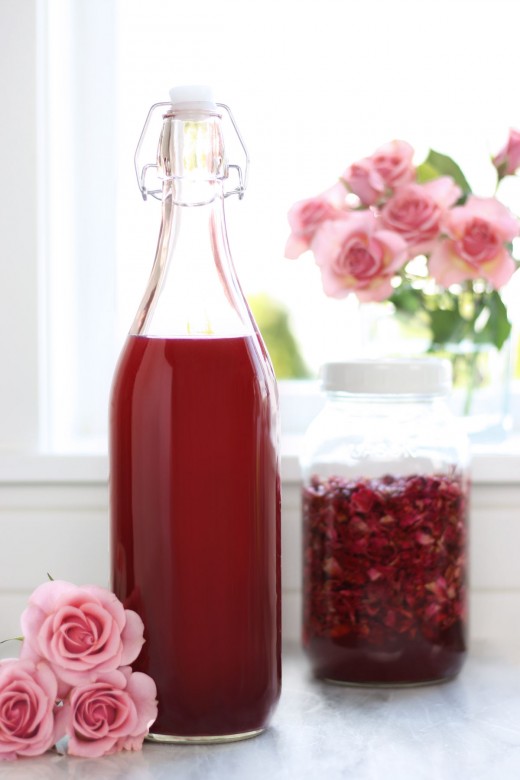
I strongly recommend using only organic rose petals. Please do not use conventional rose petals! Not only are the pesticides and other chemicals used to grow them harmful to the environment, but they’re harmful to your skin, too. Using non-organic rose petals is a recipe for irritation and other issues.
You can use any brand of apple cider vinegar you’d like, but I prefer raw and unfiltered vinegar that has retained all of its beneficial probiotics.
The slimy layer at the bottom (called the “mother”) might be unpleasant, but the mother is where a lot of the goodness is. Don’t worry, it’ll be strained out at the end so you don’t end up with bits of goo on your face.
And if you’re interested in making this recipe completely from scratch, you can even learn how to make your own apple cider vinegar with the mother at home.
Please don’t use regular canning lids, as vinegar will corrode the metal. Using a plastic lid will protect your product in case any vinegar splashes onto the lid.
Alternatively, you can use cheesecloth or food wrap underneath a regular canning lid. Consider a sustainable option like this reusable, biodegradable food wrap instead of plastic!
Full disclosure — in order to showcase the natural colour of the vinegar, I chose a clear pink bottle. However, clear bottles are ill-suited to the long term storage of the finished product.
Ideally, your rose petal vinegar should be kept in a dark glass bottle to preserve its healing properties. Light (especially UV light) will quickly break down some of the beneficial constituents.
Rose Petal Vinegar for Skin, Hair, and Scalp Health
What You’ll Need
- Raw, unfiltered apple cider vinegar
- Organic dried rose petals
- Large glass Mason jar
- Non-metal canning lid
(you can also use food wrap under a regular metal canning lid) - Wooden utensil
- Stainless steel funnel with strainer
- Dark glass container for storage
Instructions
- To begin, thoroughly clean and sterilize all your tools with your preferred method. Even though the low pH of vinegar discourages pathogenic bacterial growth, this is still a good precaution.

- Once your tools are dry and clean, fill your jar with rose petals. There is no correct amount to use. The more rose petals you use, the stronger your infusion will be.
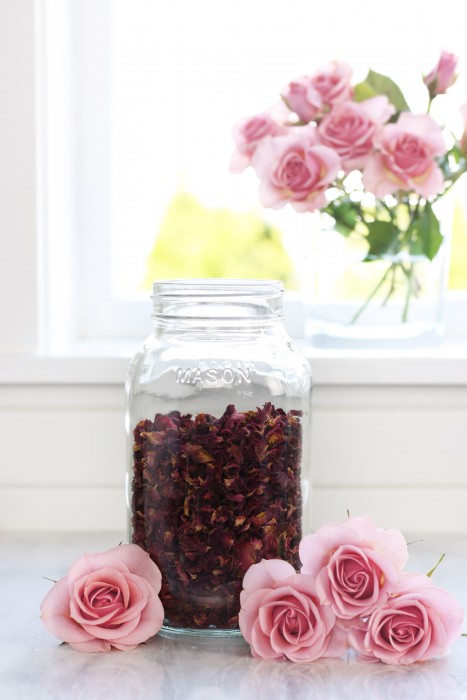
- Once you have filled your jar to your heart’s content, pour in enough vinegar to cover the petals.

- Pack your petals down with your wooden spoon until the vinegar covers them. Crushing the petals will help hasten the infusion process.
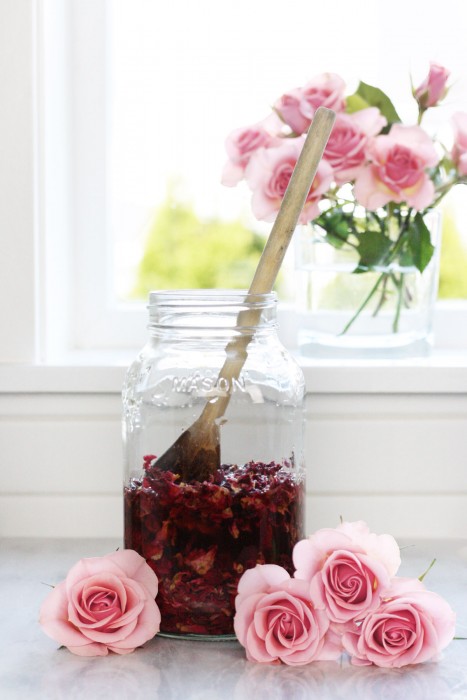
- If after this step there is more room in your jar, add more rose petals and repeat.

- After you’ve filled your jar to the top, close it with your lid (and barrier, if you’re using a metal lid).
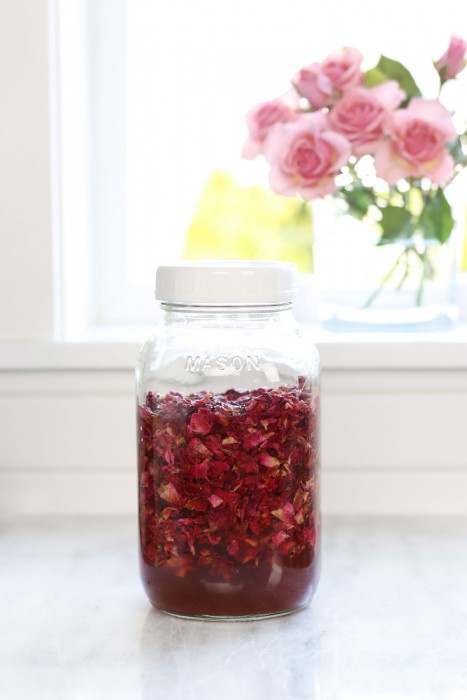
- Place your jar in a dark area and let your vinegar infuse as long as desired, preferably for at least 2 weeks (see my notes on this above). Shake gently every couple of days to disperse the liquid and ensure a potent infusion.
- Once your vinegar has been infused, strain it and transfer it to your dark glass receptacle. I used this handy funnel with a detachable strainer to expedite the process.
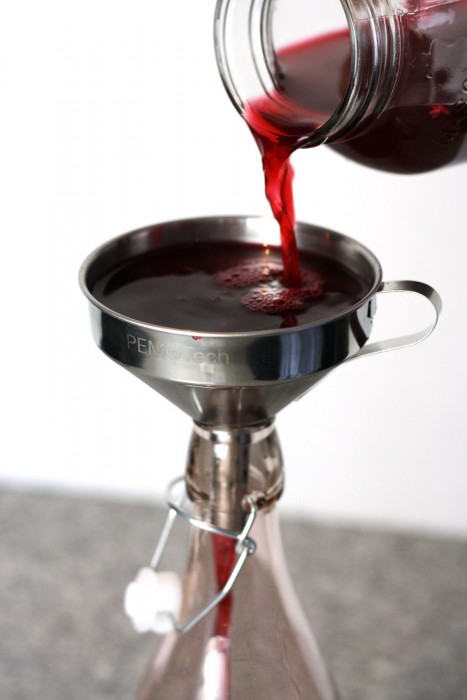
- Store your vinegar (and any products you create with it) in a cool, dark place.
Notes
This easy process will yield a beautiful, brightly coloured, fragrant rose vinegar, with a plethora of benefits for your skin, hair, and scalp.
In the future, I plan to share a variety of DIY beauty recipes that incorporate rose petal vinegar. In the meantime, here are some ideas on how to utilize your rose petal vinegar.

How to use rose petal vinegar
Rose Petal Vinegar Toner
Combine a splash of rose petal vinegar with rosewater, vegetable glycerin and a non-toxic preservative in its proper concentration (like Leucidal Liquid SF) to make a fragrant rose petal vinegar toner.
This toner will help moisturize, control oil, reduce redness, and bring your skin’s pH back to its normal acidity. As well, the probiotics in the apple cider vinegar help support your skin’s microflora, which is damaged by preservatives and constant washing.
Rose Petal Vinegar Hair Rinse
Combine a couple teaspoons of rose petal vinegar with rosewater to make a hair rinse. Our hair and scalp prefer to be a little bit acidic, but the water from our showers disrupts their pH, leaving our hair and scalp too alkaline.
This can contribute to dandruff, itching, psoriasis, and conditions such as seborrheic dermatitis. A homemade vinegar rinse as the final step in your hair washing routine will help bring the pH of the hair and scalp back into balance. It will also help the scales of the hair lie flat, reducing frizz, friction, and breakage.
To use: after you’ve washed out your conditioner, use the rinse as the last step before you get out of the shower. Squeeze out any excess water from your hair first, then pour the vinegar rinse over your scalp.
Let it sit in your hair for about a minute before towel drying and styling as usual.
Rose Petal Vinegar Scalp Tonic
Combine rosewater or mint water with a splash of rose petal vinegar and your choice of essential oils (but don’t forget the solubilizer). Rosemary and peppermint, for example, are great for overall scalp health and for stimulating hair growth.
Spritz your scalp between washes to help reduce itching, control oil, and to regulate your scalp’s pH. Shake well before use. Unless you intend to keep this spray in the fridge, don’t forget the safe preservative.
Rose Petal Vinegar Soothing Spray
This soothing spray can be used for itchy skin, bug bites, and other sources of inflammation and irritation.
Combine a splash of rose petal vinegar with mint water or peppermint hydrosol. Shake well before use. For an especially soothing sensation, I recommend storing this spray in the refrigerator.
As always, please preserve your mixture if you intend to keep it at room temperature.
More DIY beauty recipes with roses
If you enjoyed this DIY rose vinegar recipe, you may also enjoy our other rose recipes:
- DIY Chocolate & Roses Tub Tea
- DIY Rose Lotion Bars without Beeswax
- Chocolate & Roses DIY Room Spray
- Maple Rose Iced Latte Recipe
- Plumping Rose Petal Lip Mask for Soft, Plump Lips
For even more natural DIY beauty and home ideas, follow us on Pinterest! You can also find us on Instagram, Facebook, and Twitter.
Pin it for later
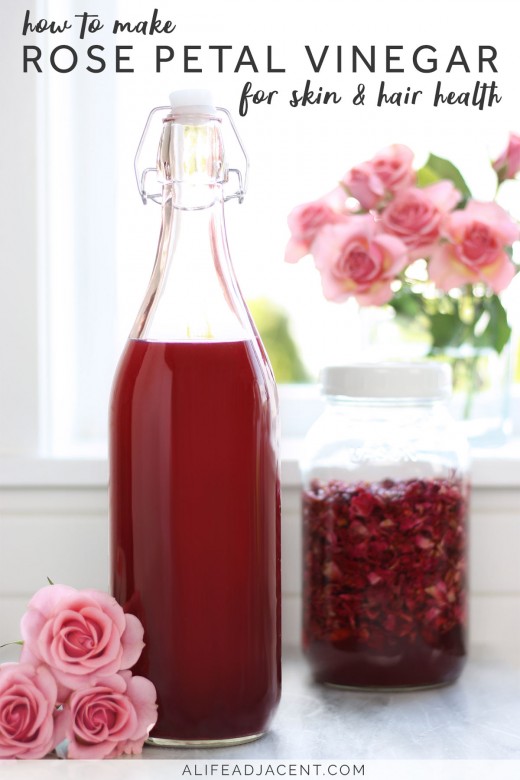
References
1 https://www.ncbi.nlm.nih.gov/pubmed/21771653
2 https://www.ncbi.nlm.nih.gov/pmc/articles/PMC3586833/
3 https://www.ncbi.nlm.nih.gov/pmc/articles/PMC4737971/
4 https://www.ncbi.nlm.nih.gov/pmc/articles/PMC4737971/
5 https://www.ncbi.nlm.nih.gov/pmc/articles/PMC3586833/
6 https://journal-inflammation.biomedcentral.com/articles/10.1186/1476-9255-8-27


diane
Friday 7th of September 2018
I have roses (wild) growing in my yard, must I dry them to use them for this. I also have shampoo ginger I want to use to make a shampoo. Will it react badly with the vinegar?
Kyla
Monday 10th of September 2018
Hi Diane, how wonderful that you have wild roses growing in your yard! No need to dry them before making the vinegar. As for the shampoo ginger, I had never heard of it before, so thank you for introducing me to such a fascinating plant. I wouldn't mix the vinegar with the shampoo as it may alter the shampoo ginger's cleansing and soaping abilites. But you could use some diluted rose petal vinegar as a hair rinse after you wash your hair. If used separately there should be no reactions. :)
Debbie
Thursday 10th of May 2018
Hi , I was wondering if I could dry and use the rose petals from my own rose bushes I have pink , salmon and red rose bushes , also could I pick and use wild rose petals for making rose water and the apple cider rose vinegar ?? Thank you for the wonderful recipes!
Kim and Kyla
Friday 11th of May 2018
Hi Debbie, thanks for reading! You can absolutely use your own dried rose petals as long as they are organic. You don't want any pesticides ending up in the finished product. Wild rose petals should be fine too, again as long as they're not contaminated with any pesticides. Good luck!
Kim
Tuesday 1st of May 2018
Hi Kristy, it’s defintiely a lot! Let us know if you tried this recipe. We’d love to hear about it!
Kristy, Life-n-Reflection
Thursday 19th of April 2018
I had to laugh when I read you accidentally ordered 2 pound of dried rose petals. Wow, that is a lot! I'd be making everything rose too! I've been wanting to try a no poo shampoo recipe last like this, but sounds as good as yours!
Reclaiming Vitality
Thursday 19th of April 2018
I love everything rose, and I can't wait to try this! I love that it is done with dried rose petals so that I can do it anytime of year. :)
Kim
Tuesday 1st of May 2018
Agreed! Dried rose petals are so handy anytime of year!